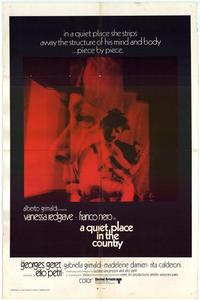
A QUIET PLACE IN THE COUNTRY
Italy, 1969, 106 minutes, Colour.
Franco Nero, Vanessa Redgrave.
Directed by Elio Petri.
A Quiet Place in the Country is a blend of horror story, mystery and psychological drama.
Franco Nero is an artist who undergoes a time in the country, analysing himself, his dreams, his imagination and memory. He is in an emotional confrontation with his mistress, played by Vanessa Redgrave.
The quiet place in the country contrasts with the industrial spirit of the city. However, the house in the country has an eerie and bloodthirsty background which impinges on the consciousness of the artist.
The film was directed by Elio Petri who was to win an Oscar in 1971 for Investigation of a Citizen Above Suspicion. Petri had a strong career with melodramas with psychological and political overtones.
The film is a fantasy, done in something of the psychedelic style of the 1960s – but Italian style.
1. The significance of the title with its irony? What expectations did this give to the film? And the fulfilment of the expectations?
2. How successful were the director's attempts at style? The swirl and movement, the garish colours, the portrayal of swirling madness? The medium was the message for this presentation of madness. How successful in its bizarre nature? Could the film have been made differently as regards style?
3. How intelligible was the film in its direct narrative line? The story of the artist, his mistress, their relationship, his breakdown, the people preying upon him? The destructive nature of the story? Was this well communicated? The basic message?
4. How well did the film communicate the modern need to get away from the industrial background of the city, its atmosphere, away to the country and its peaceful serenity and atmosphere?
5. How did the house in the country with its murderous background and history form an ironic comment on getting away to quiet places in the country? How well was this communicated and visualized?
6. How intelligible was the story of Wanda killed against the wall of the house, the flowers put there by Attilio? The fascist and war backgrounds of this story? The Italian significance of this story? The heritage of the war and the past still living in the present? The memories of the past haunting the present etc.?
7. Did you understand the murder of Flavia after the seance to bring back Wanda's spirit? The relationship of Flavia and Wanda? The effect on Leonardo?
8. The significance of the damaging of Leonardo's paintings? The accidents that had happened to Flavia?
9. After commenting on the direct narrative line, is it possible to ask what really happened? Did anything really happen or was it all in Leonardo's mind? How did the film give criteria for judging this?
10. How was the asylum 'a quiet place in the country'? The irony of this?
11. In what did Leonardo's madness consist? His art, the past, Italy, Milan, the war, art, sexuality, spirits? Comment on the details of the portrayal of this madness.
12. The significance in the film of the artist as exploited by society, as the focal point of interpreting reality? The details of the parties, agents, the need to escape?
13. The film as an allegory of artists exploited at the hands of society? An allegory of the inter-relation of the modern city to art and to nature and the past?
14. How seriously should the film be taken? Was it seriously dramatic or was it dramatically comic? Did it exploit its material? In blood, madness, sexuality?
15. How genuine a communication by a cinema of themes of madness was this film? How successful!